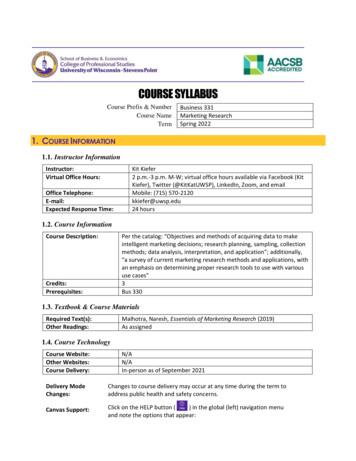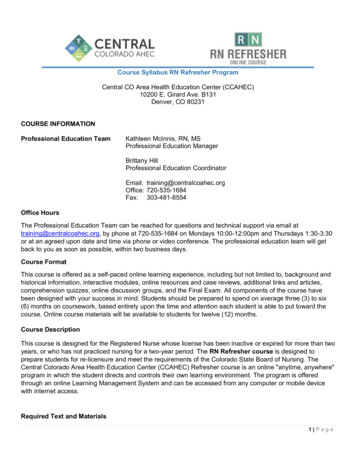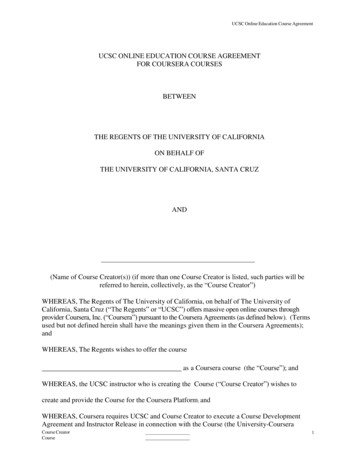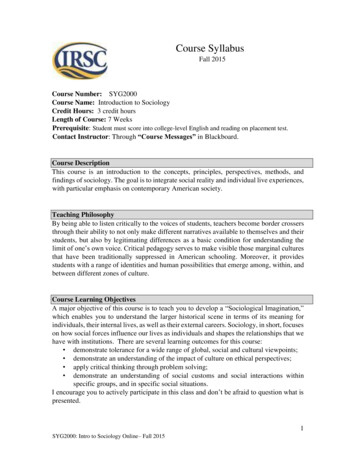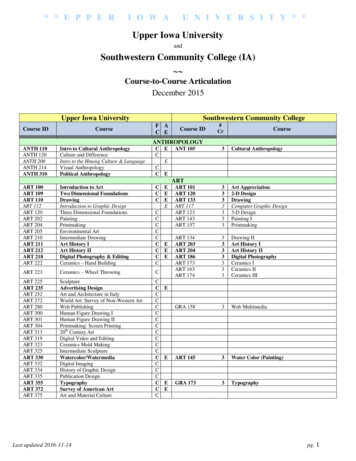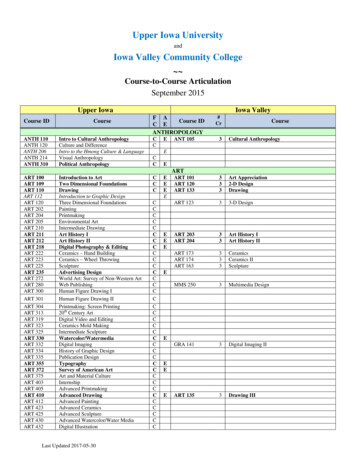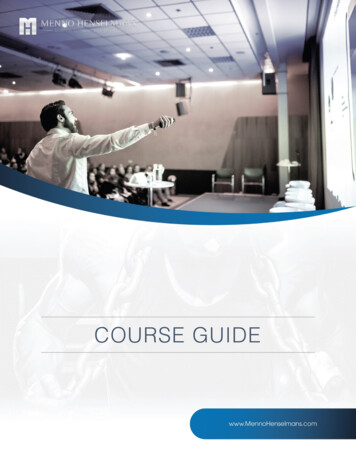
Transcription
COURSE GUIDE
2Hi there, it’s Menno, your course instructor. In this course you’ll learn how to designoptimal training, nutrition and supplementation programs for muscle growth, fat loss andstrength development. We’ll also extensively go into food choices for optimal health, dietadherence and for the professionals, there are modules on physique sports, Powerliftingand marketing your business. Let’s get you introduced.Contents (click to jump to section)How the course works3The community3Technical tips3The rules5a. Questions5b. Feedback5c. Case studies6d. Payment7e. Code of conduct7f. Copyright8Course outlineThe exam919g. 1. Open book exam19h. 2. Exercise technique videos21Technical specifications23Submission24i.3. Coaching program designCourse contributors2527
3How the course worksEvery week I will post one or several modules of the course in the course Facebookgroup. In the Comments below this post we will discuss that module during the week. Allbonus features, such as the live video Q&As, the meet-up and the exam will beannounced and discussed in a post as well, so to follow the course, all you have to do isfollow the Facebook group.The communityFeel free to comment on all the topics! Many courses include world-class athletes,academics of various disciplines and personal trainers with decades of experience.Networking and interacting with your classmates can greatly enrich your experience ofthe course. Many people from previous courses have made long-term friends in thiscourse.Of course, it's also perfectly fine if you just want to lurk in the background and read thecontents without interacting with the group.Technical tipsTo easily get into the course group, it’s useful to create a shortcut that will get you intothe group via a single click from your Facebook home page. The image below showshow you can do this.
4Most course contents, including the document you’re reading right now, have an index.If you open the Navigation Panel (Word) or Bookmarks (PDF) on the left, you will seethe index. This makes it much easier to navigate the documents.Most course documents are provided as PDF files or spreadsheets (e.g. calculators), inaddition to an online Google file format. If you don’t have software to open spreadsheetsand PDF files, you can download OpenOffice for free here.Facebook also offers the following useful features:- In-group live video Q&A.- Easy file sharing.- You can tag people you ask a question.- Nested, live comments.- You can subscribe to comment notifications by Liking a post and Unsubscribe by rightclicking in the top right corner of a post.If you’re not familiar with how Facebook groups with social learning units work, here’s a1-minute tutorial.
5The rulesQuestionsThere are a few rules to keep things organized.To centralize the discussion, please stick to the topic of the week and post yourquestions and comments in the related post. Do not create separate posts for eachquestion. It would quickly clutter up the course and every post you make sends anotification to every other student in the course.If you have a question about a topic other than the weekly topic, check the courseoutline to see if it will be discussed later. It most likely will. There are also specific catchup weeks in the course with a live Q&A video where you can ask questions about anyprevious topic.For questions that are unrelated to any topic or just general banter, please use theFacebook course chatroom thread.If I 'Like' an answer to a question without commenting, it means I agree with it and havenothing to add.Feel free to answer other people’s questions! I’m certainly not the only person in thegroup that can provide useful information and answering others’ questions is a greatway to test your own understanding of the materials.If you have extensive feedback about the course, complaints or anything you want todiscuss privately, you can email Info@MennoHenselmans.com. Serious matters will beforwarded to me for resolution. Feedback from all sources, including an anonymous
6survey, will be taken into account in the post-course evaluation to improve futurecourses. We strive to make each course better than the last.Case studiesThe exception to the rule of creating posts is posting case studies. A case study is aquestion that requires too much context to be answered in a single Facebook Comment.If you have a client case study that you would like to share or want feedback on fromthe course members, you can post it in the Facebook group if you follow these rules.1. Post it in a Q&A week. There’s a week for nutrition Q&A and a week for trainingQ&A. You can see when these weeks are in the course outline.2. Start the post with #CaseStudy and attach a document with as much informationabout the case as possible.3. State your specific (!) question.Example of a good question: How do I calculate this person’s BMR?Example of a bad ‘question’: Please design my client’s program for me.4. Include exactly what you think the answer to the question is. In the aboveexample, include all your calculations with every intermediate step, not just “Is it2043?”Then we will discuss it together.Note that a case study is for a highly specific question (or set of related questions)specific to a current course topic: we can't help you with “Please create an entireprogram for my client”. Case studies amounting to a request for free program design willnot be published.
7If you have a personal question that does not benefit anyone else, e.g. a personalmedical issue, you can email me at my clients-only email addressCoaching@Mennohenselmans.com.PaymentPlease make sure your payment is in order. If you are paying via Paypal and forwhatever reason, like insufficient funds or an expired credit card, your payment profile iscancelled, you have to re-register on our site via the registration form and select Paypalas your payment method. Re-activating the old payment profile is often not allowed byPaypal. Make sure you let us know that you re-registered viaInfo@MennoHenselmans.com so that we can cancel your new payment in time,otherwise you’ll be automatically overbilled(!)If you pay via automated bank transfer, check that you’ve set up the automatedpayment profile correctly and it transfers the same amount every month with ‘OUR’ asthe transaction cost option. If the payment isn’t automated monthly with a constantamount, my bank may not register the payment.For any questions about your payment, you can contact my administration atInfo@MennoHenselmans.com.This should go without saying, but unprofessional, unlawful or severely unethicalconduct will result in your removal from the course, the alumni network and a retractionof your certificate, if applicable. All certified graduates are expected to uphold areputation as esteemed fitness professionals. We specifically do not condone black hatmarketing, plagiarism, scams, sexism, racism or any practices that endanger yourclients or result in a disproportionate number of client complaints. For the full code of
8conduct we expect from you, see The European Register for Exercise ProfessionalsCode of Ethical Practice.CopyrightAll contents of this course are copyrighted by me. However, I’m perfectly ok with yousharing excerpts or quotes to friends or posting them online if you mention that it’s fromthe PT Course with a link.For certain practical guides, I will note explicitly that you can share them with your ownclients.Happy learning!
9Course outlineThe updated course outline - when we will discuss what - can be found below. As newcontents are posted, you will also see them pop up in the Facebook group’s learningunits. I’ll generally post new modules on Friday morning so you can study them over theweekend.To roughly summarize the course, the first part of the course deals with nutrition, thesecond part with exercise science and then several miscellaneous topics are discussed.The course outline is subject to change based on feedback during the course, newadditions and updates to incorporate new research.Week 1 How to study and do your own researchoHow to study for optimal comprehension and retentionoHow to find and read scientific papersoUnderstanding statisticsoImproving your logical reasoning skillsBiochemistry 101oHow the body produces energy from proteins, carbohydrates and fatsWeeks 2 & 3 Human metabolismoWhat is energy? Thermodynamics and energy balanceoDeterminants of energy expenditure, refeeds, set-point theory, metabolicdamage, adaptive thermogenesis, reverse dieting and the yo-yo effect Optimizing energy intakeoCutting, bulking and body recompositionoHow to optimize nutrient partitioningoHow to estimate body fat percentageoMacro tracking: common pitfalls
10oHow to measure progression and body compositionWeek 4 ProteinooProtein requirements Protein quality Vegetarians Gender, PEDs, training volume Surplus vs. deficitProtein timing Protein absorption limits The anabolic window, fasted training & workout nutrition Protein synching Meal frequencyWeek 5 CarbohydratesoTypes: simple vs. complex, GI, GL, II, fructoseoGlycogenoRequirements per type of exerciseoCarbohydrate timingoEffects on muscle growthoDietary fiberoCarbohydrate toleranceWeek 6 Dietary fatoTypes: lipids, triglycerides, fatty acidsoHealth effects and functions of the different fatty acidsoCholesterol metabolism, health effects and optimal dietary intakeoBrown fatoEffects on hormone productionoOptimal intake for muscle growth
11Week 7 Ketogenic dietingoKetosis levels, starvation mode and net carbohydrate intakesoKeto-adaptation and the keto fluoEffects on health, metabolism, appetite, performance and protein balanceoCyclical and targeted ketogenic dietingoMeasuring ketosisoMCTs and exogenous ketonesoWho is it for? Indications and contraindicationsoImplementationLive video Q&AWeek 8 Fasting and circadian rhythm effectsoIntermittent fasting & alternate day fastingoProtein sparing modified fastingoCircadian rhythm effects: timing considerations for the macronutrientsoCarb backloadingoInteraction effects between carbs and fatsWeek 9 Lifestyle factorsoCircadian rhythm controloHow to optimize sleep qualityoHow to manage stressoHow to effortlessly increase your activity levelWeek 10 Beyond macros: micronutritionoLikely deficienciesoBloodworkoMultivitamins: problems and benefits
12oThe functions of each micronutrient related to fat loss, muscle growth andperformanceoHow to fill in your microsWeek 11 Health science and food choicesoWhat makes a diet healthy?oEffects of food processing: heating, freezing, blendingoOrganic, wild and grass-fedoLow calorie sweeteners, sugar and dietary fiberoFood choices for health and anabolism: Meat, fish, poultry, dairy, eggs,grains, wheat, gluten, soy, coffee, fruits, vegetables, chocolate, coconut,nuts, alcoholoDetox dietsoFODMAPs and digestive healthoHow to recover from illnessWeek 12 Ad libitum dieting: how to lose fat and gain muscle without tracking your macrosoHow to estimate diet satietyoPhysiological vs. psychological regulation of hunger: eating speed, socialeffects, decision fatigue, sensory-specificity, portion size, biorhythmeffects, exercise, sleep, body composition, palatability, meal frequency,sweetenersoHunger management strategiesWeeks 13 & 14 Contest prep and the peak weekoPhysique sports divisionsoCarbloadingoElectrolyte manipulationoDiuretics and water cuttingo‘Shitloading’
13o PosingBeautyoAcneoTanningoCelluliteoHair lossoDandruffWeek 15 Supplements: a complete guide to every supplement worth knowing Hormones and drugsoGender-specific regulation of sex hormonesoInterpreting bloodworkoAAS: risk-reward and how to manage the side-effectsWeek 16 Nutrition case studies Live video Q&AThis marks the end of the nutrition part of the course. From here, we’ll go into trainingtopics and then at the end miscellaneous topics.Week 17 Muscle anatomy and contraction
14 Understanding muscle growth & strengthomTOR, MPS, satellite cells, myonuclei, metabolic stress, muscle damage,hyperplasia, sarcoplasmic hypertrophy, GASoSystemic and local growth regulation: structural balance theoryoStrength vs. size & functional trainingWeek 18 Cardio for fat lossoThe fat burning zoneoFasted cardiooEstimating energy expenditure per activityoNEAT compensationoEPOCoHow to mitigate the interference effectoHIIT vs. LISSWeek 19 Program design fundamentalsoooTraining intensity Effects on fatigue, connective tissue and the nervous system Strength vs. size The muscle-specific hypertrophy methodTraining volume How to estimate recovery capacity How to optimize training volume based on recovery capacityTraining frequency Interaction with volume Effects on recovery capacity How often should you train each muscle?Week 20 Program customization
15oDNA testingoMaximum muscular potential and muscular balanceoWork capacityWeek 21 Fitness for womenoGender differencesoContraceptionoPregnancyoMenstrual periodizationoBreast implantsFitness for the elderly and youthoSarcopeniaoAnabolic resistanceWeek 22 Muscle functional anatomy: a visual guideoAb training and spot reductionWeeks 23 & 24 Exercise selectionoMuscle functional anatomy: a visual guideoWhat makes an exercise effective for muscle growth?oFree weights vs. machinesoCompound vs. isolation exercisesoAccommodating resistance: biomechanics, bands and chainsoRecommended exercises and technique guideoCounting volume: how much does a certain exercise stimulate a certainmuscle?oSynergistic exercise selection: functional differentiation and how manyexercises you should do per muscle
16Week 25 Exercise technique & cueingoThe mind-muscle connectionoStrength vs. sizeRepetition tempoWeek 26 How to structure your workoutsoRest intervals oExercise ordering Active recoveryCircuit training, (antagonistic) supersets and paired setsLive video Q&AWeek 27 Periodization and progressionoProgressive overload and progression modelsoWhat is fatigue?oCybernetic/autoregulatory, undulating and linear periodizationoBenchmarking and autoregulationoOvertraining, overreaching and deloadingWeek 28 Training to failure Advanced strength training techniquesoForced reps and drop setsoRPEs and velocity monitoringoReverse pyramiding, cluster sets and myo-repsoWeighted stretchingoEccentric overloadingoPost-activation potentiationoKAATSU/blood flow restriction training
17oBreathing techniquesWeeks 29 & 30 Stretching Postural correction Warming up Injury managementoInjury diagnosis, treatment and active recoveryoPain scienceoIce vs. heat, NSAIDs and RICEoRehabilitative equipment: braces, sleeves, tapeoFoam rolling and massageoChiropracticoCommon injuries of each body part and how to treat themWeek 31 Training gearoWeightlifting beltsoFootwear: what to wear in the gymoKnee wrapsoLifting strapsWeek 32 PowerliftingoStrength vs. size program designoPeaking & taperingoPowerlifting techniqueoSelecting a competitionWeek 33 Training program case studies
18 Live video Q&AWeek 34 Adherence: the psychology of how to stick to your diet and exercise programoPsychological effects of nutritionoWillpoweroThe psychology of coachingoBlood sugaroCalorie cyclingoGoal settingoCheat mealsoDiet breaksoSocial eating eventsoHow to deal with social pressureoFood cravingsoFlexible dieting and meal planningoAssessing client adherence and motivationWeek 35 How to create a successful PT businessoMarketingoAdvertisingWeek 36 Exam preparation time with open Q&A Live video Q&A10 & 11 February 2024 Exam
19The exam“Do I have to remember all of this?” you may ask yourself at times during the course.This is a course for grown-ups, so in principle the answer is simple: remember what youlike. However, there is of course the exam for those that want to get certified. To knowwhich contents you have to remember for the exam, you can apply a 2-step rule.1) Would I ever have to explain this to a client as an evidence-based PT?If so, 2) can I easily look this up?If not, you have to remember it. If you can easily look it up or it’s the kind of informationyou don’t need regularly in practice, all you have to remember is where you can look itup in the course. Just like during the practice of personal training, you are allowed toaccess all course materials during the exam (‘open book’ exam).The exam consists of 3 parts: a theoretical exam, exercise technique checks and thecreation of a full coaching program for a mock client. The theoretical exam takes placevia ProProfs online. The technique videos and the designed program must be submittedin 1 email to Info@MennoHenselmans.com.If you pass the exam, you’ll become a Henselmans Certified Personal Trainer and you’llreceive a premium print quality physical certificate via First Class Royal Mail. If youhave an active fitness business, you can also put yourself on our directory ofHenselmans Certified Personal Trainers. The exam will be graded within 1 month aftercompletion.To test if you have the requisite knowledge to become a Henselmans Certified PersonalTrainer, you’ll have to take an online exam. The theoretical exam is conducted usingProProfs web software (the same as used for the optional interim exams after mostmodules). You can access the web app with any browser, so you can be anywhere you
20want. However, you may be required to identify yourself with your webcam or cameraand present identification to verify it’s you during the exam.You have the entirety of 2 calendar days, the weekend of 10 & 11 February 2024,Amsterdam (GMT 1) time zone, to complete it (48 hours). If you take a break, however,ensure that your internet connection is stable and your browser remains open. Werecommend you use Mozilla Firefox, Google Chrome, Microsoft Edge or Safari WebBrowser as your internet browser on a laptop or desktop computer. If you close yourbrowser for whatever reason, you will lose all your data and you will have to start over(!)There is nothing we can do to prevent client-side problems like this, so prepareproperly.It takes many people over 6 hours to complete the exam, so make sure you scheduleenough time in your agenda.There are no resists. You can only submit one exam attempt in each course.If you don't want to take the exam this round, you can postpone it to the next courseround (as often as you want) by posting it in the exam thread that will be created in theFacebook group. If you don't post that you’re postponing and don’t submit the exam,you’ll fail the exam.The access information for the exam will be posted in the course Facebook groupbefore the exam starts.The exam consists of 70 randomized questions from a large database with the followingformats: true/false, checkbox, fill-in-the-blank, multiple choice and essay/open.After the exam, we’ll anonymously grade all the answers and you get a Latin gradebased on your percentage of points achieved from the possible total assigned. If these
21numbers seem low, note that we employ negative grading, so the expected percentagepoints for taking an exam purely by random guessing is 0%, e.g. a 10-point multiplechoice question with 4 options has a 10 / 4 2.5-point penalty for wrong answers. 0-39%: fail 40-79%: pass 80-84%: cum laude 85-94%: magna cum laude 95-100%: summa cum laudeEach exercise technique video with improper form from the practical part of the examimposes a 25% point penalty on the theoretical part, e.g. if you scored 75% on thetheoretical but showed poor exercise technique during 1 of the technique checks, yourtotal score will be 50%. 97% Of students who take the exam achieve a passing mark or higher.To become a Henselmans Certified Personal Trainer, it is imperative that you candemonstrate proper exercise technique. As part of the exam, you have to upload 4videos demonstrating good form during at least 3 repetitions of each of the following 4exercises. Each video should show your entire body during the entire repetition withoutany supportive training gear: no powerlifting belt, Olympic weightlifting shoes orknee/elbow wraps. Knee/elbow sleeves are fine though.1. Either a powerlifting or Romanian deadlift.Video angle: straight from the side or slightly diagonal. Your hips should be
22visible during the full repetition.Technique criteria:a. Your lumbopelvic complex stays near anatomical position (neutral).b. Full hip lock-out occurs at the top.c. You keep the bar roughly over your center of gravity, normally meaningyour (mid)feet.2. Squat: Either the powerlifting squat or a front squat.Video angle: straight from the side or slightly diagonal. Your hips be visibleduring the full repetition.Technique criteria:a. No notable posterior pelvic tilt or spinal flexion occurs during the exercise:you retain roughly anatomical lumbo-pelvic posture.b. You hit parallel (at a minimum).c. There is no major knee valgus (caving).d. You keep the bar roughly over your center of gravity, i.e. roughly over the(mid)feet.3. Barbell standing overhead press (Military)Video angle: diagonally from the front. Your hands and hips should be visibleduring the full repetition.Technique criteria:a. You achieve full Olympic lock-out.b. The bar touches your chest or clavicle in the bottom.c. You keep your elbows roughly below the barbell.d. There is no excessive lumbar spinal extension.e. You do not use any leg drive.4. Powerlifting bench press.Video angle: diagonally from the front. Your hands and hips should be visibleduring the full repetition.Technique criteria:a. The bar touches your chest or abdomen in the bottom.
23b. You reach full elbow lock-out at the top.c. Your scapulae stay retracted and your thoracic spine stays extendedthroughout the whole set.Essentially, the video should be able to serve as a textbook demonstration of goodtechnique for that exercise.In addition to the above criteria, reasonable control over the weight, balance, maximumrange of motion and symmetry are important for all exercises. For the powerlifts, IPFPowerlifting rules also apply (section ‘Powerlifts and rules of performance’). Exerciseload, repetition tempo and your lifting attire are not graded (but may earn you stylepoints).At the start of at least one video, your face must be clearly visible and you must clearlypresent an official form of identification to the camera (e.g. driver’s license, passport orgovernment ID). If you are not clearly identifiable as the same person in any othervideo, you must also identify yourself in that video. If there are other people than youidentifiable in the video or involved in the creation of the video, including any cameraoperator, you need to obtain written consent from them and inform them the video maybe watched by any course tutor or administrator.If you have a medical pathology reasonably preventing you from the proper execution ofone of the exercises, please list this instead of the video and provide formal proofthereof (e.g. a doctor’s note or an x-ray).Technical specificationsAll 4 videos should each be fewer than 100 MB in size, have a minimum resolution of640x480 and be no longer than 2 minutes in duration. All videos should be unedited andhave intact meta data (if you don’t know what these are, they should be intact, asthey’re automatically created) so we can see the creation time.
24SubmissionPlease check your submission fulfills all the above requirements. Watch each video andcompare it to a video demonstration of that exercise from the course. Could your videoreplace that video? If not, make a better one. There are no resits for the exam.When you are satisfied with your videos, upload each video to Youtube, GooglePhotos/Drive, Vimeo or Dropbox without a password. Then, put 4 hyperlinks to the 4uploaded videos in 1 email to Info@MennoHenselmans.com. In this email you shouldalso link to or attach the copy of the identification document you presented in the video,as well as the program you designed (details in section below).Use the following template for your email.From: [your registration email address]To: Info@MennoHenselmans.comTitle: PTC Exam technique videos & program submissionHello,Here are my technique videos for the PTC exam, along with a copy of the ID I show inthe video.Deadlift: [link]Squat: [link]Overhead press: [link]Bench press: [link]ID: [link or attachment]All persons involved or shown in these videos have provided written consent for theirinvolvement. The videos or their metadata have not been edited in any way.
25Regards,[your full legal name]Do not send the videos as file attachments.The email should be sent from the email address you registered with for the course,otherwise you should very clearly note that you’re using a different email address.You have to send the email before the end of the theoretical exam.To become a Henselmans Certified Personal Trainer, you need to have experiencecreating fitness programs. The program should include everything a client would needto get started to achieve their goals. The program can be for yourself, a client or even afictitious person.Concretely, you’ll need to implement the learning objectives provided at the end of mostmodules in this program. For example, for the Energy module you’ll need to calculatethe person’s energy expenditure and target energy intake and for the Exercise Selectionmodule, you’ll need to recommend which exercises the person should do. Module bymodule, you will this way create an entire fitness program for your subject this way. Theprogram should contain everything someone needs to successfully follow it on theirown, including a strength training program, diet and supplementation (if applicable), as ifit was for a paying client.Write out all calculations and your thought process for every decision you make.
26At the end of the course, collect everything into 1 document, saved as a PortableDocument Format (PDF). You can use the provided spreadsheets and case studiesfrom the course as a template for this. However, you can only upload 1 file. If youcreated additional files, such as a spreadsheet, you can link to those from within theuploaded file. You have full discretion over exactly how you present the program.Imagine you’re a client receiving your program: does it contain everything you need toget started on your fitness journey?The programs should follow the spirit of the course guidelines. Since program design ispart science and part art, for many aspects of a program there are no hard right orwrong answers. As long as your choices are reasonable, you will pass. If your choicesare clearly unreasonable or not in line with the course recommendations without clearjustification, we may deduct up to 50% points from your exam score.Good luck and enjoy the course!
27Course contributorsThe Henselmans PT Course is officially authored by the following people, inalphabetical order. Anastasia Zinchenko: researcher, writer, editor Antoine Fombomme: tutor of the French PT Course, editor Fredrik Tonstad Varvik: researcher, writer Joe Flaherty: editor, writer Luis Villasenor: tutor of the Spanish PT Course, editor Menno Henselmans: founder, chief editor & creator Nevin Barnett: tutor of the French PT Course, editor Reinier de Wit: researcher Richard Bell: tutor of the Dutch PT Course Sanne Leenman: recruitment consultant Sten van Aken: researcher Stijn van Willigen: editor, researcher, graphics designer Thomas Campidell: researcher, writer, tutor of the German PT Course Vincent Huisman: writer (business module only)
Most course documents are provided as PDF files or spreadsheets (e.g. calculators), in addition to an online Google file format. If you don't have software to open spreadsheets and PDF files, you can download OpenOffice for free here. Facebook also offers the following useful features: - In-group live video Q&A. - Easy file sharing.



